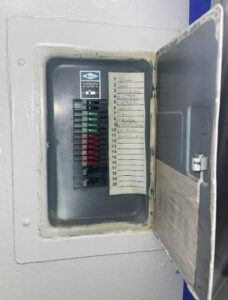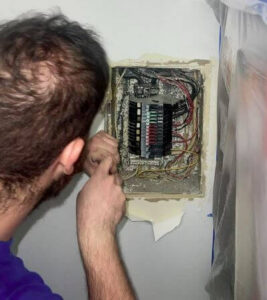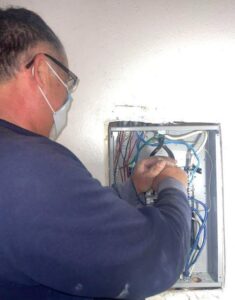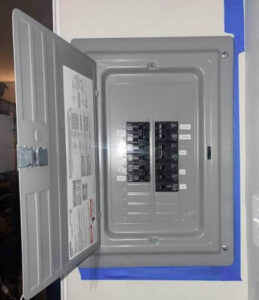However, many older multifamily buildings are equipped with outdated electrical panels, such as Zinsco, Federal Pacific, Challenger, or Pushmatic panels, which have garnered a notorious reputation for their safety issues.
In this article, we will explore the dangers associated with these panels, why there is a need to replace them, and whether insurance companies are requiring a change.

The Dangers of Zinsco, Federal Pacific, Challenger, or Pushmatic Panels
- Zinsco Panels
- Federal Pacific Panels
- Challenger Panels
- Pushmatic Panels
- Eaton, Eaton Challenger, Eaton/Cutler-Hammer Panels
- Bulldog Panels
- Square D Panels
The Need for Panel Replacement
How to hire the right electrician for the job.
The Dangers of Zinsco, Federal Pacific, Challenger, or Pushmatic Panels
Zinsco Panels: Zinsco, also known as GTE Zinsco-Sylvania, electrical panels were popular in the mid-20th century and commonly installed in homes built in the 1970s. However, they were recalled in 2002 due to inherent design flaws that have several inherent issues, including:
- Stab-lok Breakers: Zinsco panels are notorious for their “Stab-lok” breakers, which are known to trip infrequently or not at all when overloaded, posing a severe risk of overheating and electrical fires.
- Aging Components: Over time, Zinsco panels tend to deteriorate, resulting in loose connections and poor electrical contact, which can lead to overheating and potential hazards.
- Obsolete Design: The Zinsco design does not meet modern electrical safety standards and is no longer manufactured.
Signs of a Zinsco, Sylvania, or GTE Sylvania panel:
- The panel has a Zinsco, Sylvania, or GTE Sylvania label
- The panel’s breakers are brightly colored and thinner than current breakers
- The panel’s circuits melt instead of shutting off the power
- The panel’s bus bars corrode easily
- The panel’s breakers melt into the bus bar
- There is soot outside of the panel
- A breaker is blown out

Federal Pacific Panels: From 1950 to 1990, builders installed millions of Federal Pacific Electric (FPE) circuit breaker panels in homes across the country. FPE panels were one of the most common circuit breaker panels on the market during that time. The company has been out of business for decades, but the old panels are still found in countless homes and apartment buildings. And many of those breaker panels have Stab-Lok circuit breakers that are now known to be defective.
Because of faulty manufacturing and design, FPE panels are linked to many electrical fires. Up to one in four Stab-Lok breakers in FPE panels are faulty. In fact, as many as 2,800 house fires each year are started by these faulty breakers! The primary concerns associated with these panels include:
- Breaker Reliability: FPE breakers are known to have a high failure rate, meaning they may not trip as intended during overloads, which can lead to overheating and electrical fires.
- Lack of Certification: FPE panels lost their UL certification due to serious safety concerns, further highlighting the potential dangers.
Challenger Panels: Built by Challenger Electrical Equipment Corp or Eaton/Cutler-Hammer, these panels were manufactured and installed in homes during the 1980s and 1990s. In 2011, the U.S. Consumer Product Safety Commission (CPSC) recalled them due to a fire hazard. The main concerns are:
- Faulty Circuit Breakers: Challenger panels, particularly those manufactured between the 1980s and 1990s, have been reported to have faulty circuit breakers that might not trip when overloaded, posing a risk of overheating and electrical fires.
- Aging Components: Like many older panels, Challenger electrical panels may suffer from aging components, leading to loose connections, corrosion, or deteriorating breaker performance, which can compromise electrical safety.
- Obsolete Design and Parts: Challenger panels are no longer manufactured, which can present challenges when it comes to finding replacement parts or breakers. This limitation can affect the repair and maintenance of these panels, potentially leading to safety issues or necessitating panel replacement.
- Outdated Standards: Some Challenger panels might not meet current electrical safety standards and building codes, potentially leading to regulatory non-compliance and safety concerns.
Why were they recalled?
- The breakers could overheat under normal conditions
- The breakers could cause expansion and contraction
- The breakers could cause arcing between the circuit breaker and the bus bar
- The connections inside the panel could become loose, leading to increased resistance and heat buildup

Pushmatic Panels: Pushmatic electrical panels are considered unsafe and should be replaced. These panels were commonly installed in homes from the 1960s to 1980s. They pose concerns due to:
- Obsolete Design and Parts: Discontinued manufacturing makes finding replacement parts challenging. Limited availability of qualified electricians familiar with Pushmatic panels can impact maintenance and repairs.
- Operational and Safety Issues: Breakers may not trip properly during overloads, posing fire hazards. Aging components could lead to loose connections or deteriorating breaker performance, compromising safety.
- Code Compliance Challenges: Outdated design might not meet current electrical safety standards or building codes, raising compliance concerns.
Eaton, Eaton Challenger, Eaton/Cutler-Hammer Panels: The CPSC (Consumer Product Safety Commission) recalled Challenger’s Type HAGF-15 and HAGF-20 circuit breakers in 1988. After Challenger went out of business, it was bought by Eaton/Cutler-Hammer, and in 2014, they had to recall even more breakers, as parts of the panel were easily exposed, making it even more of a shock hazard.
Bulldog Panels: Also known as Pushmatic panels, they were installed in homes and businesses in the 1950s. These panels are considered obsolete and pose a fire risk.
Why they are dangerous:
- The aluminum wiring can overheat and melt, which can spark a fire
- The panels have ungrounded wires, which can be a fire risk
- The circuit breakers may not trip properly when overloaded, which can cause a fire
- The breakers are grease-fed, which can make them difficult to operate if they aren’t used and serviced regularly
- The panels were designed for homes that used less electricity, so they may not be able to handle the increased electrical loads of modern homes
Square D: Which Square D breakers were recalled?
This recall involves Square D models FA, FH, FI and FY one-, two- and three-pole circuit breakers rated 15 to 100 amps and model KI two- and three-pole circuit breakers rated 110 to 250 amps. The F model breakers were manufactured from May 8, 2013 to June 10, 2013 and have date codes 13193 through 13241.
The Need for Panel Replacement
If you’re lucky, you won’t have to worry about replacing electrical panels if you don’t have the type of sub panels that your insurance company won’t insure. An electrician familiar with the requirements of insurance companies will be able to determine what kind of panels you have and if they are still considered safe by insurance companies.
There are several compelling reasons to replace Zinsco, Federal Pacific, Challenger, or Pushmatic panels in multifamily buildings:
Safety: The primary reason for replacing these panels is safety. The unreliable breakers and aging components in Zinsco, Federal Pacific, Challenger, or Pushmatic panels pose a significant fire hazard. Upgrading to modern panels with better safety features reduces the risk of electrical fires and injuries.
Code Compliance: Many local electrical codes and regulations now require the installation of panels that meet modern safety standards. Non-compliant panels can result in code violations and fines.

Insurance Company Requirements: While not all insurance companies explicitly mandate panel replacement, some do. Insurers are increasingly aware of the hazards associated with Zinsco, Federal Pacific, Challenger, or Pushmatic panels and may require their replacement to underwrite coverage. Insurance premiums may be higher for buildings with outdated panels, as they are considered higher risk.
Resale Value: Upgrading the electrical panel in a multifamily building can increase its resale value and make it more attractive to potential buyers or tenants.
Reliability: Modern panels are more reliable and efficient, reducing the likelihood of power interruptions and ensuring uninterrupted electrical service.
While insurance companies may not universally require panel replacements, they increasingly recognize the hazards associated with these panels and may incentivize or mandate upgrades.
Additionally, adhering to modern electrical safety standards ensures that multifamily buildings are not only secure but also compliant with local regulations, protecting the well-being of all occupants.




